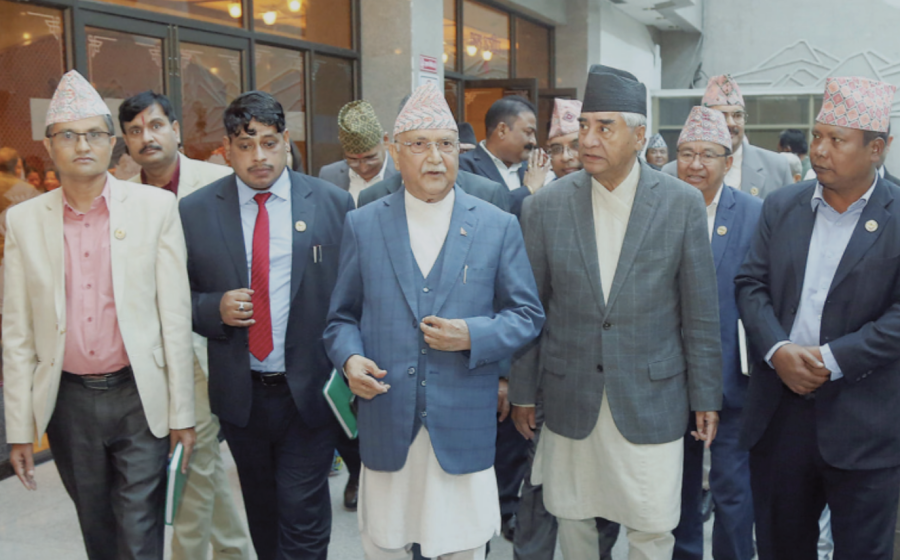Politics
Observers cast doubt over the longevity of Congress-UML coalition
The collaboration may not be smooth sailing as the two parties are the major competitors in national politics, they say.
Purushottam Poudel
The Nepali Congress and the CPN-UML, the country’s two largest political parties, have come together to form the government for the first time in almost a decade.
Backed by the Congress, UML chair KP Sharma Oli staked his claim to the prime minister’s post within hours after President Ramchandra Paudel invited a member of the House of Representatives to show a majority in the lower house with the support of two or more parties by Sunday evening.
Following the failure of Pushpa Kamal Dahal, the outgoing prime minister, to secure a majority in Friday’s floor test, President Paudel on Friday evening invited political parties to form a new government under Article 76 (2) of the constitution.
Article 76 (2) of the Constitution of Nepal states that the President appoints as prime minister a member of the House of Representatives who can secure a majority with support from two or more parties. Soon after the President’s call, UML chief Oli presented the signatures of 165 lawmakers (including 88 from the Congress and 77 from the UML) to show the House’s majority in his favour.
Oli will be appointed the new prime minister by Sunday evening as no other leader from any party in Parliament can produce a majority.
And with that, the Congress and the UML have now entered a new phase of collaboration. As per the deal, the two parties will head the government on a rotational basis for the remaining term of Parliament.
Leaders from both parties say that they decided to join hands with specific goals, mainly of ensuring political stability, reviewing and amending the constitution, and giving an impetus to the country’s sluggish economy.
The two major political rivals have jointly run the country on some occasions in the past, for at least half a dozen times. The latest instance was in the Sushil Koirala government in February 2014 formed after the second Constituent Assembly election. The Congress-UML administration was formed with the key mandate of promulgating the constitution, which they successfully did in September 2015.
The two parties first collaborated to run a government in the Krishna Prasad Bhattarai-led government in 1990. The key mandate of that government was to promulgate the constitution and hold first the parliamentary elections after the reinstatement of multiparty democracy that year.
After that, they ran a coalition government in 1996, led by Girija Prasad Koirala. That government was formed to hold general elections amid a challenging time as the erstwhile CPN (Maoist) had just launched an insurgency. The two parties also collaborated in the Koirala government formed after the Second People’s Movement in 2006 that produced the Interim Constitution in 2007.
In the first Constituent Assembly, too, the Congress and the UML shared power. This was the first time the Congress was in a government led by a UML leader. In 2009, the then second-largest party Congress had supported UML leader Madhav Kumar Nepal, who now chairs the CPN (Unified Socialist), as prime minister after the fall of the Pushpa Kamal Dahal government. The UML was the third-largest party at the time.
There were collaborations between the Congress and the UML on other occasions as well but that was with splinter factions such as the Nepali Congress (Democratic) led by Sher Bahadur Deuba.
Despite their long experience of working together, the two parties’ collaboration may not be a smooth sailing this time around, political observers say.
They argue that UML leaders and party committees may follow the decisions made by Oli as other leaders are less likely to challenge his decisions. But in the Congress, there are a number of factions, due to which the cooperation of the Congress-UML coalition may face challenges.
“The UML is a party which works in a centralised system in which no one challenges the final say of their chief Oli, whereas in the Congress, though Deuba prevails most of the time, he is often challenged by other leaders,” Chandra Dev Bhatta, a political analyst told the Post. “When two parties have different orientations and working styles, they are bound to have challenges in running the government.”
Pradip Paudel, a Congress leader, said if the party president comes up with a valid agenda that benefits the general public and the country, all Congress leaders cooperate with him. “It's true that we oppose the decisions that are not in favour of the country and its public,” Paudel told the Post.
But it's not true that two big parties cannot cooperate with each other, Paudel argued. “Despite the differences in schooling and working styles, we have instances of the two parties delivering when they had a specific mandate,” he said.
In 1990 and 2014, the two parties forged coalitions to promulgate the constitution, which they did. “The number of spoilers in those days was fewer than what it is today,” Bhatta added. “The collaboration may go smoothly for a few months after government formation, but they will have issues later given that these two parties are competitors in national politics.”
But another political analyst CK Lal has a different opinion. Lal said that the Congress opted to cooperate with UML due to its diminishing confidence. Until the Congress regains its lost confidence, this coalition government won’t face a major problem, Lal added.
In the 2022 elections, despite the Congress securing the highest number of seats in the federal parliament, the UML received the highest number of votes in the proportional representation category.
“Being the largest party in the lower house of Parliament, the Congress seems to have acknowledged that the UML is the largest political force in the country, and that is the reason the Congress became ready to accept the UML’s leadership,” Lal told the Post. “Besides, the Congress possibly accepted the UML’s leadership to ensure they don’t tie up with the Maoist Centre next election.”
Many leaders from the two parties argue that strengthening democracy can be a common reason for the two parties banding together. The two parties may be competitors but they fought together at least twice against the monarchy to restore democracy.
But analysts say these two parties, which are eyeing better performance in the next general election, might not pursue a long-term cooperation.
Congress leader Paudel said that the future of their alliance with the UML might be in question only if Oli tries to run the government unilaterally.
“Until the party leading the government respects the senior coalition partner, I don’t think there will be any problem in the government’s continuation,” Paudel added.
Until July 1, leaders of these two arch-rival forces were engaged in accusing each other of involvement in huge corruption scams. Congress leaders accused UML leaders’ hand in the Giri Bandhu Tea Estate land swap scam while the UML pointed to Congress leaders’ role in the Bhutanese refugees scam.
Prithvi Subba Gurung, a UML deputy general secretary, said that partnership in the government “does not necessarily mean we cannot question the other for the mistakes we believe the other party has committed.”
“This coalition is for political stability in the country,” Gurung told the Post. “But it does not mean that leaders from both parties should be barred from pointing out each other’s mistakes.”




 16.12°C Kathmandu
16.12°C Kathmandu













%20(1).jpg&w=300&height=200)

